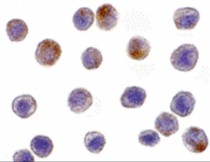ARG54694
anti-TRAF3 antibody
anti-TRAF3 antibody for ELISA,ICC/IF,Western blot and Human,Mouse,Rat
Cancer antibody; Cell Death antibody; Immune System antibody; Signaling Transduction antibody
Overview
| Product Description | Rabbit Polyclonal antibody recognizes TRAF3 |
|---|---|
| Tested Reactivity | Hu, Ms, Rat |
| Tested Application | ELISA, ICC/IF, WB |
| Host | Rabbit |
| Clonality | Polyclonal |
| Isotype | IgG |
| Target Name | TRAF3 |
| Antigen Species | Human |
| Immunogen | Synthetic peptide (15 aa) within aa. 20-70 of Human TRAF3. |
| Conjugation | Un-conjugated |
| Alternate Names | LMP1-associated protein 1; EC 6.3.2.-; CD40 receptor-associated factor 1; LAP1; CAP-1; CD40-binding protein; CAP1; CD40BP; IIAE5; CRAF1; CD40bp; TNF receptor-associated factor 3 |
Application Instructions
| Application Suggestion |
|
||||||||
|---|---|---|---|---|---|---|---|---|---|
| Application Note | * The dilutions indicate recommended starting dilutions and the optimal dilutions or concentrations should be determined by the scientist. | ||||||||
| Positive Control | HeLa Cell Lysate |
Properties
| Form | Liquid |
|---|---|
| Purification | Affinity purification with immunogen. |
| Buffer | PBS and 0.02% Sodium azide |
| Preservative | 0.02% Sodium azide |
| Concentration | 1 mg/ml |
| Storage Instruction | For continuous use, store undiluted antibody at 2-8°C for up to a week. For long-term storage, aliquot and store at -20°C or below. Storage in frost free freezers is not recommended. Avoid repeated freeze/thaw cycles. Suggest spin the vial prior to opening. The antibody solution should be gently mixed before use. |
| Note | For laboratory research only, not for drug, diagnostic or other use. |
Bioinformation
| Database Links | |
|---|---|
| Gene Symbol | TRAF3 |
| Gene Full Name | TNF receptor-associated factor 3 |
| Background | TRAF3 Antibody: Tumor necrosis factor (TNF) receptor associated factors (TRAFs) are the major signal transducers for the TNF receptor superfamily and the interleukin-1 receptor/Toll-like receptor (IL-1/TLR) superfamily. TRAF3 was first identified by its interaction with CD40 and the Epstein-Barr virus transforming protein LMP1. Several TRAF3 mRNA splice variants exist and some of these can activate the transcription factor NF-κB. Besides CD40, TRAF3 also interacts with the TRFR superfamily member lymphotoxin-beta receptor (LTbetaR) in association with TRAF2 and the apoptosis inhibitors cIAP1 and Smac. It has been suggested that TRAF3 induces mitochondria-mediated apoptosis upon binding of the TNF family cytokine LIGHT by LTbetaR. |
| Function | Regulates pathways leading to the activation of NF-kappa-B and MAP kinases, and plays a central role in the regulation of B-cell survival. Part of signaling pathways leading to the production of cytokines and interferon. Required for normal antibody isotype switching from IgM to IgG. Plays a role T-cell dependent immune responses. Plays a role in the regulation of antiviral responses. Is an essential constituent of several E3 ubiquitin-protein ligase complexes. May have E3 ubiquitin-protein ligase activity and promote 'Lys-63'-linked ubiquitination of target proteins. Inhibits activation of NF-kappa-B in response to LTBR stimulation. Inhibits TRAF2-mediated activation of NF-kappa-B. Down-regulates proteolytic processing of NFKB2, and thereby inhibits non-canonical activation of NF-kappa-B. Promotes ubiquitination and proteasomal degradation of MAP3K14. [UniProt] |
| Highlight | Related products: Anti-Rabbit IgG secondary antibodies; Related poster download: The NF-kappa B Pathways.pdf |
| Research Area | Cancer antibody; Cell Death antibody; Immune System antibody; Signaling Transduction antibody |
| Calculated MW | 64 kDa |
| PTM | Undergoes 'Lys-48'-linked polyubiquitination, leading to its proteasomal degradation in response to signaling by TNFSF13B, TLR4 or through CD40. 'Lys-48'-linked polyubiquitinated form is deubiquitinated by OTUD7B, preventing TRAF3 proteolysis and over-activation of non-canonical NF-kappa-B. Undergoes 'Lys-63'-linked ubiquitination during early stages of virus infection, and 'Lys-48'-linked ubiquitination during later stages. Undergoes both 'Lys-48'-linked and 'Lys-63'-linked ubiquitination in response to TLR3 and TLR4 signaling. Deubiquitinated by OTUB1, OTUB2 and OTUD5. |
Images (2) Click the Picture to Zoom In







